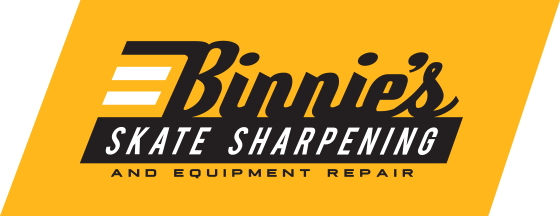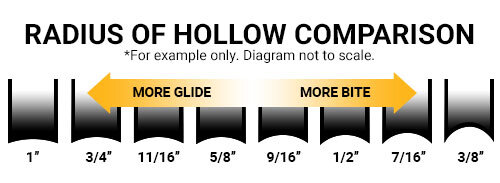Pro's Corner: Skate Sharpening Basics
Let Binnie’s help you make sure you understand what skate sharpening is and how to get the best sharpening for you.
If you’re new to hockey, the concept of sharpening your skates can be daunting or confusing. Most players, and particularly new players, drop their skates off at the local hockey shop or skating rink and get “the usual” whatever that it.
The basic concept of skate sharpening is where the steel blade of a skate is clamped into a holder (or jig) and moved across a spinning grinding stone to gently grind away the bad or unwanted steel. This spinning stone, called a finishing wheel, is contoured to a specified radius which creates the depth of hollow and two sharp edges. Sometimes, if a skate is brand new, needing a drastically different hollow, or if there are defects like rust or pock marks in the steel, the skate will be passed over a cross-grinding wheel first. This wheel, often made of a coarser and harder material, spins vertically instead of horizontally and creates a nearly flat grind on a pair of skates.
When sharpening a pair of skates, you can customize a few elements to help you skate faster, be more balances, turn sharper, and fatigue slower. These customizations are the radius of hollow (RoH) and the profile of the blade.
Radius of Hollow
The radius of hollow (also known as depth of hollow or RoH) is how deep your skate is cut in comparison to the radius of a given circle. Typically, these are measured in 1/8” increments from 1” to 3/8” but many qualified skate sharpening professionals can sharpen to 1/16” increments and do much more flat cuts than 1”. The below diagram shows the various hollow cuts.
Deeper hollows tend to provide more bite or edge and are typically for smaller or lighter skaters that don’t always have the size to drive their edges into the ice, net dogs, and corner grinders. It’s usually the players that like a lot of quick acceleration, the ability to make faster, tighter turns in smaller spaces, and the ability to lock down their edges when getting pushed around in front of the net or digging in the corners. The con to a deeper hollow is it generates more friction and resistance, shrinking the amount of glide time and can lead to enhanced fatigue measures. A shallower hollow is used by many pros, bigger guys, and players with great edge control. The reduced hollow requires more kneed flexion to drive the edges into the ice, which can slow immediate acceleration, but provide longer stride time and enhances reserved speed while gliding. This can also reduce fatigue measures by not having to take as many strides over time. The most common radius of hollow cuts are ½” and 5/8” for skate sharpening shops because it provides the best balance between edge depth and glide speed.
| SHALLOW HOLLLOW | VS. | DEEPER HOLLOW |
| Harder and tighter turning | More forgiveness in turning with less bite | |
| Greater immediate acceleration | Better gliding and retained speed | |
| Better grip on ice for stability in battle situations | Ability to “slide” into position due to reduced friction | |
| For goalies, it can benefit push offs and quick movements | For goalies, it can benefit small lateral movements with less resistance |
Profiling
Profiling a skate, sometimes called a contour or rocker, means shaping the overall arch of the blade from front to back. Most factory profiles are 9’ to 11’ for player skates and 24’ to 28’ for goalie skates. While many people are satisfied with the factory profile, it is worth noting that skates fresh out of the box can have slightly different profiles due to the blades being mass produced. This is why it is important to have your skates custom profiled so you know they are the same, even if you’re getting the “factory” profile.
Much like your choice of radius of hollow, your profile is determined by your size and style of play. Usually, smaller players and those who like a smaller turning radius will have a smaller profile. The smaller profile will place less blade on the ice at any given time, making for more aggressive turns, acceleration, and changes of direction. Players that have a smaller radius, however, need to be much better with their balance because of the reduced surface area contact. In contrast, players with more flat profiles increase their balance and ability to subtly change direction by being able to slide more. They can also retain more speed in turns, but they increase their turning radius.
When a skate is profiled, you can not only decide the size of the arc, but you can also decide if you want it slightly forward or backward. This is known as the balance point. The balance point is determined by how you skate. By profiling the skate forward of a center you shift your balance backward. This is great for enhancing backward skating and transitions. Moving the balance point backward of center enhances your forward lean and increases take-off acceleration.
Still not sure what the perfect hollow and profile is for you? Contact us and we’ll help you figure it out!


